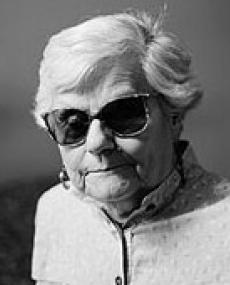
Bettie Du Toit was born on 15 July in 1910, on a farm in the former Transvaal Province. She was orphaned at three when her father died. Her mother had passed away when she was 18 months old. This resulted in her growing up at a boarding school under the guardianship of the Dutch Reformed Church at Platteland in the Transvaal. At 18 Du Toit left the Platteland and settled in Johannesburg in 1928, where she met trade unionist Johanna Cornelius. Under Cornelius' guidance Du Toit involved herself in trade unionism and political activism. Her involvement with the trade unions made her unpopular in the National Party (NP) and her only brother.
At the time Cornelius and Du Toit met South African textile workers were on strike over unsatisfactory employment conditions and low wages. The Textile Workers Union was seeking volunteers to help organise workers and the 19-year-old Du Toit offered her services. The owner of the factory she was assigned was Jewish and worried about a trend towards anti-Semitism in South Africa and Du Toit's anti-racist and anti-Nazi sensibilities appealed to him. He allowed her to organise his workers and offered her a position as weaver. She was accused of being a Communist and suffered public rejection after posters bearing the accusation were put up in Huguenot.
During the textile workers' strike in the 1935 Du Toit and four other women were taken to the Fort Prison in Johannesburg and fined one pound or 10 days labour. In an interview with Luli Callilinicos Du Toit remembers that the following day newspapers had huge headlines, "5 WHITE GIRLS IN A POLICE PICK UP VAN". It caused great uproar. After her release Du Toit committed herself assist and fight for the rights of workers, especially White Afrikaans girls that worked under appalling conditions. Du Toit worked side by side with other prominent unionists like Ray Alexander, Moses Kotane and Wilton Mkwayi. Du Toit worked with various trade unions such as the Pretoria Match Workers' Union, the Textile Workers Industrial Union, the Transvaal and Natal Canning Workers and National Laundry, Cleaning and Dyeing Workers Union (NLDCW). She was later appointed as the Secretary of the NLDCW Cape Town branch. In the 1940s she became secretary of the National Laundry, Cleaning and Dyeing Workers' Union branch in Cape Town, and in 1943 she was elected to the national executive of the Trades and Labour Council, which later became the Trade Union Council of South Africa (TUCSA). She was one of the few whites to participate in the 1952 Defiance Campaign, joining Patrick Duncan, five other whites and 31 others in entering Germiston without a permit.
Apart from being a trade unionist Du Toit also played a role in the political struggle of South Africa. She protested the Asiatic Land Tenure Act, also known as the Ghetto Act, and was one of the volunteers in the Defiance Campaign. It was her involvement in the this campaign, which led to her banning in 1952 under the Suppression of Communism Act. According to this Act Du Toit was prohibited from taking part in any trade union activities for the rest of her life. During her banning Du Toit started writing a book titled UKUBAMBA AMADOLO, or Go Slow. This book looks at the workers' struggle in the textile industry, where she spent most of her time. In her interview with Callinicos she describes the difficulties she experienced writing the book. The people she meant to interview were afraid to be seen with her for the fear that they might also be banned or imprisoned.
Despite being banned Du Toit helped found a welfare organisation known as Kupugani in Soweto. To enable her to fulfil Kupugani's work she had to travel to Soweto in disguise at night, but before long the police discovered her activities. Fearing long-term imprisonment after numerous arrests her friends and political colleagues convinced her to leave the country. Du Toit finally left South Africa without a passport and went into exile in 1963. She fled to Ghana and worked for Radio Ghana, but eventually moved to London. At the time of her interview with Callinicos in 1987 Du Toit had lost her sight after an ear infection that developed into Steve-Johnson disease and had taught Braille to other sight-impaired people. After spending years in London she returned to South Africa, the feisty Du Toit returned to trade union organising and spent some time in Natal where she worked with H.A. Naidoo to improve the standard of housing for sugarcane workers. where she passed away on 31st January in 2002.